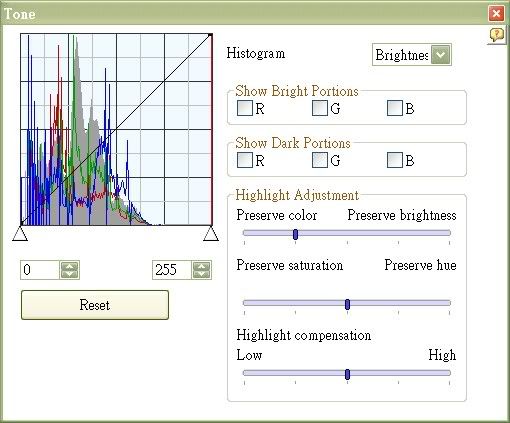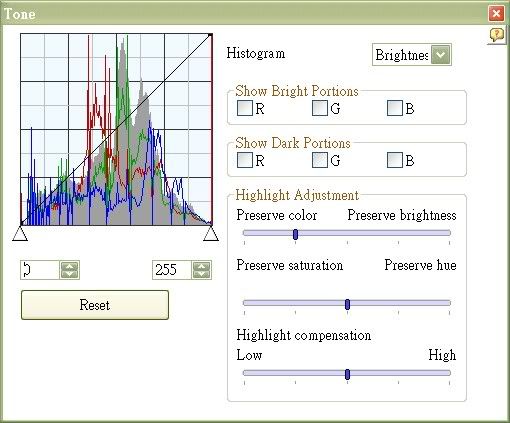http://www.pbase.com/tcom/k10d
Well, when I inspected those comparison shots between the DA* 16-50 against the DA 16-45 as well as those of the DA* versus the DA 21 Limited, I found an obvious irregularity, that is, underexposure. ( Um, it should be "regularity" for Pentax DSLRs, though :-( )
First look at the church photos taken with the DA* 16-50 and the DA 16-45 lenses, I read the EXIF information and discovered that a huge amount of +ve exposure compensation were applied for the two wide angle shots made with the DA* 16-50 and the DA 16-45 at 16mm, i.e., in a value of +1.7EV both for the same scene with the same framing/composition. What does this mean? It simply means that serious underexposure had occurred for the uncompensated metering reading when the shooter attempted to take the shots. Do note also that he put his K10D camera in the Matrix metering mode when he took the pictures.
People may start to argue that the scene is a bit tricky to the light meter for for the lighter wall of church and the bright sky above it. However, I really don't think it is a very difficult scene to be handled with for typical matrix meter with should be somehow intelligent and in this case the K10D matrix / multi-pattern meter simply failed to handle such a situation. And then some people may argue again that the Pentax meter was just trying to preserve the highlight. But I just wish to point out that no blown/burnt out of the sky even after the +1.7EV compensation in the sample pics posted. So, I just wish to ask *what* is/are the camera was trying to "preserve"? What??
So, let's go on to inspect another pairs of photos. This time we can see the church shots taken with the DA 21 lens along with the DA* 16-50 also. The 21mm shot was made with a +0.3EV compensation whereas the DA* 16-50's one was taken with a +0.7EV, which simpy means that the DA* underexposed more than the DA 21, for the same scene with pictures taken at nearly the same time. We can also draw another rough conclusion that the wider the angle in used, the K10D tends to underexpose more when we compare the shots taken at 16mm with the same DA* lens and the DA 16-45, even the two pairs of shots should be taken at a different time which the weather conditions might be different. Well, the K10D user still used the matrix/pattern metering mode and underexposure did still occur, again.
In fact, the underexposure problem of the Pentax DSLRs are the same old problem which seem has never been and could not be cured by Pentax since their old first *ist D. Just look at the set of quick tests and experiments carried out by another K10D user below:-
http://blog.xuite.net/allison_tabris/tabrisphoto/10528261
(Text in Traditional Chinese, you can use Babelfish to translate.)
From the above page, we can see that even fixed pattern metering, i.e., the Spot meter, of the K10D underexposes much and indeed it is rather inaccurate. For a dark mouse, a +ve EV exposure compensation could still be required - this simply violates the basic rule and working principle of light metering for a reflective light meter and is actually rather abnormal amongst all other light meters on Earth which are calibrated to meter correctly for the mid-grey/tone. In fact, with such rather inaccurate Spot meter of the Pentax DSLRs, even of their current "top" model the K10D, the real purpose of a Spot meter is totally defeated as every user uses this mode is supposed to be aiming for the highest possible accuracy and total control in metering. Of course, if a Pentax DSLR user is to adapt for such abnormality, he should always aim at the dark (areas) when using the Spot meter(ing) as an attempt to get proper exposure, but then this is actually very improper, frankly.
And then I can guess some people will still argue that I do not know about the actual condition of the above test shots as I am not the one who was at the site and took the picture. Well, no problem with this, I will show my photo then. Below is a picture took with my K100D on a scene which I don't think is something really very difficult, although the subject was lit by the sunlight:-
I shot RAW and the picture below is the direct original picture without any digital exposure compensation:-

The corresponding *original* exposure histogram actually looks like this:-

Well, in order to rescue the picture to make it looks better again and as close as it could look like as the real scene, a large amount of +ve exposure compensation is inevitable. Actually, to bring it back to the normal sunshine look, a significant large amount of +1.5EV is required, in the Pentax Photo Laboratory. After the correction, the histogram looks more healthy now then, as below:-

But the fact is the whole "corrected" picture now just looks flatter and the building looks less pop than it should be, than *if* proper exposure was achieved *at* the time of exposure by applying the same +1.5EV exposure compensation (but then this *must* require trials and errors *at* the *field* which just means more time wasted but with less photo opportunities - when the time is being wasted, photo opportunities would go away too). Besides, the shiny feel and the colours of the picture becomes a little bit worse too, after the "correction". Now, we have:-

So, proper exposure is *always* the best thing we want and bad exposure and underexposure is just an evil which is *always* undesirable. Well, again any more "preserve highlight" *theory* (by those Pentax defenders)? Well, what can we look from the original histogram distribution above? In fact there is nothing close to clipping, even that we inspect the individual histogram curve for the individual R, G or B colour channel. The whole histogram simply skewed heavily to the left and left *much* room in the right. In my book (and actually in any book about light metering), this is simply called UNDEREXPOSURE.
So, afterall, what's the true advantage of such underexposure if it is really intended. I'm afraid that the true answer is None but the reverse is true. Digital compensation cannot do all the magics but only that inferior picture quality will be resulted - Here is a more detailed and systematic analysis.
To compare with other better DSLRs in the metering and exposure department, take the Canon 5D as an example, which will seldom let me down in shooting under the sunlight, even with bright or even very white subjects and scenes, which the 5D is clever enough or at least much cleverer than the Pentaxes to handle these quite well and yields very satisfactory results with a much higher hit rate and more acceptable results, even when dealing with more tricky scenes and objects. Here are two quick examples, which were made directly out of the camera as in-camera jpegs, just and merely by aimed and shot (no re-touching of any kind has been made except for down-sizing):-


Truly speaking, such kinds of very annoying underexposure problem, with variation with lenses and focal length, etc., is really one of the big reasons to *force* me not to get any Pentax DSLR body "upgrade" further but I need to go with the Canon for a new body not only just for more pixel count.
Unless Pentax is willing and/or able to make a brand new designed body with improved metering and exposure, I think this would be very hard to be acceptable, at least by my own (minimum, I think) standards and requirements. Or, if they are not just so stubborn to not go back to their old but actually reliable 6-segment metering which used in their MZ line of SLRs and quite some popular high end film P&S as well as a few very early Optio DCs, the problem will never disappear, I bet. For a few more examples on how inferior underexposure could spoil photos and how other "proper" DCs/DSLRs can do better (including my old trust-worthy Optio 330 which just has the old 6-segment pattern metering), see my this old *ist D comparison gallery:-
http://ricehigh.net/Samples/samples.html
There isn't a lot of true in this article. It's loaned information with a biased explanation. I'm shooting with a Nikon D80 and Pentax K10D and there is yes a difference in metering between these two body's. The D80 is more difficult to handle in the sun because the sky is almost every time burned when there is a DR challenge. The K10D has a much better exposure on these conditions. I have the two DA* lenses and some others. The only lens which is difficult on the K10D is the Tokina 28-70 2.8. this lens needs always a +1/2 stop comp.
ReplyDeleteI hope you do better research next time. You're isolating a problem and search prove with it and ignores all those images every where where the exposure was correct. Even reviews from magazines don't mentioned these problems.
Good luck with your blog, but as a reviewer you have still a lot to learn.
So, what're you going to explain for all the above cases and tests as illustrated and quoted? And yes, underexposure preserves all the highlights but you will get underexposed pics too in which you have lost many some other things else!
ReplyDeleteWhy not just expose right or even Expose to the Right?
Isolated cases are NOT a representation of the whole story.
ReplyDeleteI did a quick test on pbase with the K10D as subject. Randomly i picked out some photos and looked at the exifs. There should always be a +EV comp if you're story is true where the exposure was correct. Sadly for you this isn't the case, and that's my own experience too. Both my K10D and D80 are fine machines to work with. The D80 has quicker af lock with less accuracy, the K10D has better jpegs and raw files. Now you think: Better Jpeg...yes that's the truth, less artifacting then from the D80. This translates in much more wiggle room in PP before the consistency of pixels break up.
Using therms as "Expose to the right" feels like you need a ego boost just to prove you know what this is. It doesn't impress me though.
My conclusion stands: You're research is not scientific is just an opinion on loaned information.
Is like reading a newspaper and then say you're really have prove What's going on in the middle east. But actually have nothing only hearsay. Did you know that middle east newspapers have a different view on the same situation then American newspapers.
But hey, you're entitled to have an opinion. But don't be confused and say you have found the truth with this elaborated research
I quote you: "And yes, underexposure preserves all the highlights but you will get underexposed pics too in which you have lost many some other things else!"
ReplyDeleteThis sentence can serve as an example why you're biased. I never said in my post that my K10D has exposure issues, only with one lens? But then again you was eager to use this info to tell me that underexposure is so bad and better...
You didn't see the nuances of the information? You're so trained in saying the same thing over and over again that there isn't any room for actual thinking. A trained dog comes to mind!
psychopappa, good try but don't bother. Logic is not his strong point ;)
ReplyDeleteAnyways see these 2 images. Technically (based on the mean) these 2 images are 1/2 stop different. But a greater difference is in contrast more so than exposure. The second one has it's contrast "expanded", as do most of the Pentax shots AFAIKT.And actually most digital shots do.No "exposure compensation" applied.
hist compaired
expanded contrast
you have a Canon and a k100. Is it so difficult to take the same picture w/ each camera????????
ReplyDeletePsychopappa, you've repeatedly emphasized and re-iterated that the cases I reported are isolated and I'm biased. How about you then? What "solid evidence" (as you always emphasize) you *actually* have in your hands which you can draw up with the conclusion that the K10D exposes perfectly and mostly (as you've strongly implied)? Are you NOT biased actually?
ReplyDeleteAs you say I have my opinions and indeed yours are of no difference than mine from that perspective. The worse is you've shown us nothing, before you made your claims and drew up the conclusion too early. Why and how can you conclude that I must be wrong, especially when I refer to my own experiences with examples shown as well as some additional sample photos and tests/experiments carried by others too.
If you do not find any problem with your K10D, that's fine. I'm glad that you're happy with it. But you have no point indeed to point out that what I tell in my article are untrue and invalid.
I also wish to point out that you're not satisfied the D80 you used is just totally irrelevant to whether the K10D has more accurate metering, too. It is just that the D80 you used did not meet your requirements and standards - and so do I for the K10D and K100D in the metering department for mine. Following your same logic, D80 lovers will start to bash you for being blamed their beloved cameras to be bad, it is exactly just like what you're doing now which is indeed rather meaningless.
Finally, you said that you inspected some random samples from the Pbase and verified that there are no exposure compensation, I just wish to ask have you ever checked on the EXIF info of my converted clock building image for the same thing?
> Anonymous said...
ReplyDelete> Anyways see these 2 images. Technically (based on the mean) these 2 images are 1/2 stop different.
The scenes in the two pictures are different and as such merely comparing the mean values are meaningless. Instead, to inspect the distribution of the histograms would.
> But a greater difference is in contrast more so than exposure. The second one has it's contrast "expanded", as do most of the Pentax shots AFAIKT.And actually most digital shots do.No "exposure compensation" applied.
So, Post Processing is still required for the Pentax's original image whereas the Canon's one has been done right out of the box (or at least is far better, even it is not perfect). That's the main difference and the key point.
> Anonymous said...
ReplyDelete> you have a Canon and a k100. Is it so difficult to take the same picture w/ each camera?
Good idea and actually I have already done that shortly after I got my 5D in June. Do you want to have a new blog entry on that? I'm sure I shall take more new pairs of comparison shots and post more photos here when I write this article.
The "mean" and averages and numbers are the only thing the meter understands. Consider the simple case of a full frame "dumb" meter. No zones or weighting. The only option available to it are to add up all the values and expose to the ANSI standard of 110. This would be based on the "average" of the entire scene.
ReplyDeleteCW only weighs the different averages to come up w/ a new average. MATRIX metering is another story. You cannot detrmine what the exposure should be without knowing the averages and weighted average of each "zone". Again exclude matrix which is a bit more complicated in logic. That the pictures don't come out to your liking is not a camera fault but your mis understanding of what it's metering and how it's calibrated.
Yes I want you to take the exact same picture with the 2 different bodies. Is that really so hard?????
ReplyDeleteBut all the sample photos I posted and referred/linked to in my this article were taken with/in the Matrix/Pattern metering mode - and that's all about the "intelligence" of different Matrix meters I have been talking about. On the other hand, the quick tests and experiments carried out in another quoted blog article were using the Spot meter of the K10D - and that's simply about the metering "accuracy" I have been talking about. Well, who has ever talked about the plain average metering this time?
ReplyDeleteAnd, if you like a histogram which skewed mostly to the left in between the lower half portion of 0-127 (like my own posted clock building sample photo taken with my K100D in Matrix mode), then I think you must have a very special taste of your own. Still, if you like it, that's fine but I bet most other DSLR shooters out there would not!
Finally, do you know how many steps of brightness/lightness levels there are in between the 0-127 zone?? Answer here.
> Anonymous said...
ReplyDelete> Yes I want you to take the exact same picture with the 2 different bodies. Is that really so hard?????
No problem, I shall write a new blog article on that later.
I have quite some comparison shots already. But if I'm going to do a truly systematic and formal comparison test as you have been asking for, I shall use tripod, same composition with the same (effective) focal length, comparable tone/colour mode (I suppose I shall set my K100 into Natural mode and my 5D in the Neutral or Faithful mode, with all settings in the centre) and so on..
Guy, give me some times, I promise I shall do that and publish my report and you (and all others as well) who are interested will not be disappointed! Thank you for your suggestion anyway! (that is what exactly I have been planning to do!)
Personally I have no use for matrix metering. IF that was important to me I'd get a Nikon
ReplyDeleteFunny how communication works, I'm always pleased when i see a reaction as yours. But let's get on topic.
ReplyDeleteWhy do i need scientific proof, I'm not writing a blog with so called scientific research i have only a opinion on this matter. And like most opinions there is a biased foundation. This is the red line in my post..I'm explaining that you have an opinion biased by whatever experience you have in the past and whatever back..it..up information you can find.
You write opinions in your blog, and they are biased by nature. And i mentioned this before: You're entitled to have one.
Scientific research is a completely different story. Like normalized test conditions, statistics, results which can repeated over and over again etc..etc..
If you showed the procedure for your so called testing conditions to an actual scientific lab you would really look bad.
I love my D80 and K10d i use them both daily. I never said that the D80 was a bad cam it has only different issues then the k10D.
Conclusion: I have a biased opinion and you have a biased opinion. But don't hide it behind so called scientific proof, certainly i don't.
Seems one of your heroes has a problem w/ Canon metering.
ReplyDeleteQuote:
My Canons, which also consistently overexpose and on which I set -2/3 compensation, at least overexpose the same amount all the time, so I can leave the compensation at -2/3 most of the time. I set the compensation and forget on my Canon and other Nikons.
.....unquote....
makes me wonder.....
http://www.kenrockwell.com/nikon/d80/d80-performance.htm
That link is a year old.
Psychopappa, who says my Blog (not my Homepage!) is scientific? Have you read the themes of my *BLOG* in the subject title? Or even you haven't read my first article in my blog for Why This Blog, I supposed that you should be able to read at least this to understand what you're reading here, otherwise there would be too many imaginations of your own and you could never understand and digest anything, no matter where you visit and read on the web! Not only here!
ReplyDeleteHighrice, this is your *lamest* excuse to this day ...
ReplyDeleteAlthough you seem to have very little respect for your readers, especially those who take the effort to try to communicate with you, I'm pleased you agree that you have a biased opinion. That's all what i wanted to see and hear. I think it's important that others can see how your reasoning works! And your writing here is excellent for that, thanks.
ReplyDeleteOpinions are opinions in which I have my observations and viewpoints. Blogs are blogs where in mine I write my opinions under my set themes.
ReplyDeleteSince you are still unable to understand my themes and what my blog is for and keep continue to put words on my mouth and twist every meaning of my words which I've said or have never said, I just keep trying to "communicate" with you and hope that you could read and understand, but in vain, anyway. I do respect everyone here, including you, but then of course you can think in whatever ways you like - still, I shall open up the space for you (and all others as well) to express your own *opinions*.
Rice, I am a K10 owner myself and I totally agree with you. The underexposure problem mars shots that would've been good. I find myself constantly applying positive EV compensation in ACR, sometimes about +2.0! And this does not go without trace indeed. The sky becomes noisy, the shadows lose details. The article you cited, http://www.luminous-landscape.com/tutorials/expose-right.shtml really hits the spot - by underexposing (exposing to the left) we really lose a lot.
ReplyDeleteNow, after this issue and a lot of reports about bad quality of new star zooms, I'm thinking about switching to the 5D too.
Your homepage is not "scientific" either. Just a collection of a small sample of tests . NO comment on Mr. Rockwell's use of negative EV on Canon???? Again you ignore "inconvienent" facts...
ReplyDeleteI'll like iliks comment best...very convenient post must say. Agrees in everything wants a 5D also. Writing style almost like...eh you fill in the dots.
ReplyDeleteAnd then the name (I Lik), do you see what i see?
> Anonymous said...
ReplyDelete> Your homepage is not "scientific" either. Just a collection of a small sample of tests .
Yes, that's a problem of bad samples of mine or even just purely user errors on my part, despite the (large) number of Pentax lenses and Pentax DSLR bodies (different models of different generations for both) I have had.
> NO comment on Mr. Rockwell's use of negative EV on Canon???? Again you ignore "inconvienent" facts...
Do you actually know what Canon models did Mr. Ken Rockwell use for his statement made? Nonetheless, an overexposing Canon or Nikon D80 would not make an underexposing Pentax to expose correctly, will it?
Today I had time with Nikon D80 and I have to agree with Psychopappa - it is easer to get good exposure with Pentax than with Nikon. Ofcourse there is some underexpousured Pentax shoots, but I better take home underexposured photos than one with blown highlights.
ReplyDeleteWith this comment I try to say that in this price range you have to give some excuses.
ilmars, I think the overexposure issue is also something related to the internal tone curve as set in the cameras by default.
ReplyDeleteTake my 5D as an example, if I use the "Standard" Picture Style which is with a "Type II" tone curve which is somehow relatively exaggerated for the contrast and brightness, overexposure will be more easily resulted. If I use Neutral or Faithful Picture Styles which are with a "Type I" tone curve, preservation of highlights will be much better (as Phil Askey has also mentioned this in his review already).
As for Pentax's case, the Natural "colour" mode is with a more faithful and linear tone curve which is again quite favourable for preservation of highlights and will yield wider Dynamic Ranges too. In this case, if the exposure level is right, the produced images will have fine quality in terms of the DRs (which are wider than those exaggerated tone curves) and noise levels (which are lower than those underexposed ones).
i think your observations are right, but this situation is not as "fatal" as you try to mention.
ReplyDeletefor most people it takes a time to learn the way that their camera "think". so i can live together with this "problem" becouse i know that in wich situation what kinda compensation required by me.
it's amost like you shoot men in black - you know (the camera doesen't) that you have to compensate (-) otherwise the result will be overepxposed.
so every cam's meter has it's own behavior. some of them are closer to average perfect exposure, some of them are far, but the worse meter's logic can be made out.
(sorry for my english, i'm hugarian)
laszlo mudra (mulder.hu)
First, let me say that your whole blog seems to have a complete lack of equality in common sense review procedures and is nothing more than your opinion in how you feel you weren't catered to enough and have everything done for you.
ReplyDeleteWith that said, you also seem unaware of how to correctly compare products of obviously differing qualities. Your so called "scientific comparisons" are far from it. I will use this blog post for example.
First, you have no baseline upon which to compare these 2 cameras. If you truly cared about putting out a thorough and well thought out comparison, you would have taken two identical shots with both cameras in manual mode with the same settings(aperature, shutter speed, and ISO) and in RAW. Then from those comparison shots you can evaluate the baseline exposure tendencies and then gone forth comparing the two cameras' sensors' abilities to correctly expose the photograph by shooting in different modes while trying to keep most of the parameters controlled (ie DON'T BASE ALL OPINIONS ON AUTO MODE).
Also, the shot from the Pentax is a RAW photograph while the Canon is an in-camera jpg. Don't you think that Canon does some exposure compensation in there in-camera processing? Once again, another reason why your lack of converted RAW shots makes this comparison very much disputable.
I did this to hopefully help you realize that the processes you utilized for this comparison were very inaccurate and in no way represent either cameras true functionality. I own a K10D and do agree it has a tendency to underexpose but usually only by 1/3 of a stop. That is honestly very negligable compared to the claims you are making and is easily correctable in PP with very minimal to no loss in IQ.
I believe that my analysis of your post is unbiased (despite the fact I have a K10D) and that you will reconsider your post which clearly shows your biased (and unfounded IMO) opinion of Pentax's qualities as being inferior.
And for christ's sake, take some photos, stop criticizing every little nitpicking detail and have fun!
Hello. First of all, unlike some of the other comments you have received, I don't mind the "negativity" that some have commented in your posts. Rather, I admire the refreshing "honesty" in your posts and I have learnt a lot from your posts.
ReplyDeleteRegarding your post around the "underexposure" tendency, I do agree with some of your other comments that since the comparisons are not of the same scene and taken under different conditions it's hard to say whether Pentax is underexposing compared to the Canon.
I am a Pentax K10D owner, and previous to that owned the *ist D, and previous to that a film SLR (can't remember which model though).
I have just returned from a trip to Japan where I took over 6000 photos. All were taken in RAW mode, under various conditions (from dark indoor scenes, to rainy days, to bright sunshine). On some, but not all, I have applied exposure compensation (ranging from -1 to +1).
Having processed a lot of these photos, I cannot agree with your view that the Pentax has a tendency to underexpose. Yes, it does tend to underexpose shots with blue (like your example) but it also overexposes shots with lots of green. But this is pretty standard with most cameras I have used, I tend to automatically compensate these days even before shooting.
In processing many of these shots, I typically don't need to manually adjust exposure compensation in post processing, except for difficult shots.
So if you like, please consider this a counter-example to your views.
I also compared some of the shots I took on the Pentax with shots (taken at the same location at roughly the same time and conditions) taken on a Canon IXY 20 with the latest DIGIC III processing engine. I would not say that the Canon is better at exposure than the Pentax. In fact, in some cases, I would say the Pentax is better at avoiding white clipping. Yes the resultant picture is slightly darker, but at least no detail has been lost.
I bought a K10D because of the great features you get for the price.
ReplyDeleteI have witnessed exactly what you mention in this blog RiceHigh. *My* K10D does tend to underexpose. I know exposure.
I have researched this phenomenon far a wide, and what I have found can be summarised as such:
* Some K10D's underexpose
* Some K10D's overexpose
* Some K10D's are just fine
It would be an interesting exercise to see whether certain batches do one or the other. Maybe even to see whether Pentax tweaked the exposure of a later batches to fix the failings of an earlier ones (?).
There are reports that the exposure problems can be fixed by swapping it's focusing screen with that out out of (or made for) the *ist DS. I haven't tried that so cannot verify it's true. Can anyone verify this?
I have 2 k10d's - one is spot on and the other is underexposed by 1/2 EV - someone should tweet this to pentax
ReplyDeleteanonie mouse
I purchased a k 10d with 3 of the pancake primes. It would routinely underexpose by 1-1.5 ev. I brought it back and got a second one. It did the same thing. It would not have been horrible if it underexposed in a consistent manner but it seemed random to me. I therefore could not compensate for it except in post processing. The tech looked at it and said it was fine. He implied that I did not know what I was doing. (I have been using SLR cameras for 25 years. At one point I was carrying a camera all day everyday. Did this for 4 years straight. In any case I did not feel like fighting with the store over the camera) I ended up selling the whole set up for a $1400.00 loss 6 weeks after purchase. The random underexposure drove me mad.I only had enough money left to get an Olympus E 510 with a kit lens. For the money the olympus is an okay camera. It has never taken the kind of pictures the pentax took when it was working correctly. (Of course I did not have any money left to buy a decent lens for the olympus after the pentax experience.) The funny thing is that the kit lens for the pentax came after I sold the camera. I now have a brand new kit lens that has been sitting in my drawer. Prior to this experience I had a Pentax Super Program film camera which was fantastic. I am thinking about giving Pentax another chance. (However the Nikon D7000 is getting mighty tempting. Especially for the price.)
ReplyDeleteI have done some informal research on this problem and have found that numerous people have had similar experiences.
Maybe I just got 2 cameras from a bad batch.
My K10D also underexposes for some lenses:
ReplyDeleteSigma 18-50 f/2.8 macro = OK (0,5 stop or less)
Sigma 50-500 EX APO (old model) = approx. -1,0 EV
Tamron 70-300 = approx. -1.0 EV
The worst are the Sigma 10-20 at 20mm and the Pentax 18-55 which came with my Ist DS. Underexposure is approx. -1,5 EV.
TV mode seems the worst for any lense (I generally use AV).
On a uniform background, the exposure mode makes no difference.
Sometimes it drives me crazy.
I also own a Nikon D700, whose metering is a long way ahead, but I still like my Pentax system... when I have the right exposure.
P. St-Gelais